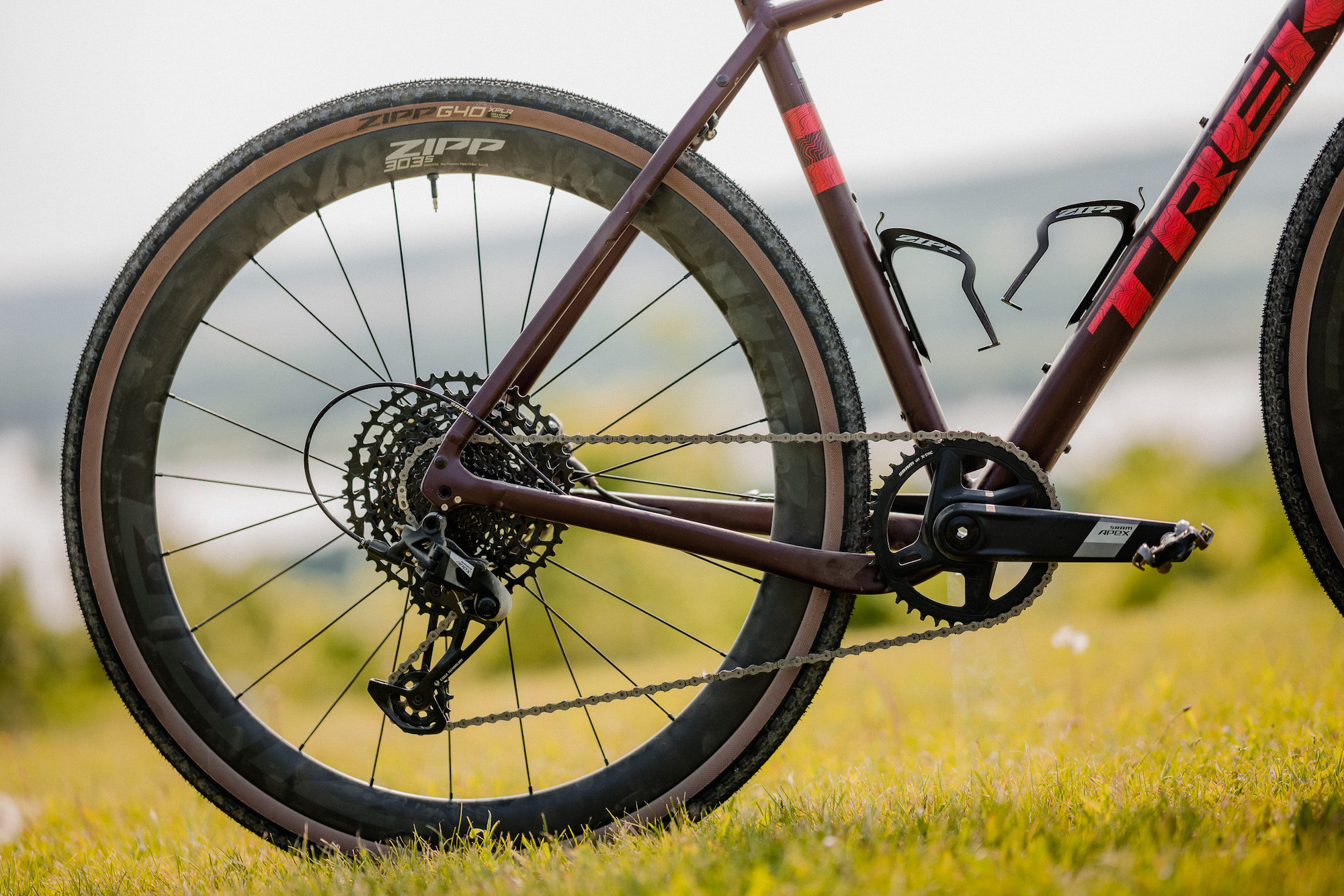How to convert your road bike into a gravel bike
Here's what you need to set up a road bike for riding gravel

If you’re thinking about riding gravel but not ready to buy another bike, with just a few part swaps you can use your road bike to confidently ride gravel. While it’s possible to ride a road bike with robust tires on hard-pack dirt and fine gravel, you’ll likely have more fun and have better control on loose surfaces with a more gravel-oriented setup. With some strategic part swaps and component conversions, you can even set up a bike for use on both road and gravel — a true All-Road bike.
Gravel tires

One of the smartest and easiest part swaps to make your road bike into a gravel bike are wrapping your wheels in gravel tires. If you’ve rim brakes, tire options may be limited by the amount of space between the top of the tire and the inside of the brake caliper, and/or the gap between the tire and the seat tube. Check with the frame manufacturer about tire size recommendations, but you should anticipate tires that are less than 28mm if you’ve rim brakes.
Those with disc brake equipped bikes will have many more tire options to choose from since there are no limiting rim brake calipers (you’ll still need to check for tire clearance behind the seat tube). Disc brake rims with tubeless tires can keep you rolling even after a puncture, which may be more likely on unpaved surfaces. Like those converting rim-brake bikes to gravel bikes, check with the frame manufacturer regarding tire clearance.
If you’re already using disc brakes and riding wheels with ample frame clearance, look for tires that offer additional grip for cornering and also offer a smooth center tread for rolling on paved surfaces. Tires like the Schwalbe G-One RS (pictured) are excellent for mixed use riding.
| Read More: Best gravel bike tires of 2023
If you plan to ride gravel, but also want to roll fast with groups on the road, an option is getting a set of dedicated gravel wheels with gravel tires, and swapping to a road setup when riding on pavement. While not the most budget-conscious option, it is a practical one. Another option for those riding 700c road wheels with disc brake rotors is to buy a set of 650b wheels and mount gravel tires. The smaller rims will allow an additional 10mm of tire clearance behind the seat tube. Make sure to check for tire clearance between the chainstays.
Gravel Gearing

Swapping road cycling gearing for gravel gearing will allow you to keep your pedal stroke smooth and efficient, especially when ascending off-road. If you’re on a 1x-drivetrain setup, a chainring swap is a relatively simple upgrade; you’ll probably want a slightly smaller ring for riding gravel than the road. Make sure to match the chainring bolt pattern and size/spacing if you plan to make this swap. Using a wide-range cassette will allow you to spin your legs when you need to, but also turn a large gear when riding on smooth surfaces.
The latest race content, interviews, features, reviews and expert buying guides, direct to your inbox!
If you plan to swap from a 2x-chainring setup to a 1x-chainring setup, also consider mounting a rear derailleur with a clutch,to manage chain slap, a chainring with a narrow-wide tooth profile to reduce the likelihood of chain drop. A chainwatcher for a 1x setup will further protect against chain drop.
When retrofitting your drivetrain, check out gravel-specific groups like SRAM XPLR, Shimano GRX, or Campagnolo Ekar with clutch-enabled rear derailleurs that minimize chain-slap, as well as wide-range gearing.
If you’re riding a traditional chainring setup, go with compact gearing (34/50) in front matched with a climbing cassette (11-34). Moving to smaller chainrings and larger cassettes may necessitate adjusting your derailleurs.
Gravel pedals

While you can use road pedals on a gravel bike, a swap to gravel or mountain bike pedals will allow clipping into the pedal on either top or bottom, which is easier to do when unclipping in and out on tricky surfaces. Also, off-road pedals shed dirt and mud more effectively than road pedals, which is a bonus when getting dirty while riding gravel.
Swapping pedals is easy to do with the correct tools. A 15mm pedal wrench with a long handle offers leverage to remove spindles stuck in crank arms. Some pedals may also accommodate an 8mm hex wrench on the inside end of the spindle. Use high quality tools and a steady hand to prevent stripping pedal spindle or crank arm threads. Don’t be parsimonious when applying grease to these parts, and there’s no need to over tighten pedals as the pedaling motion will keep pedals from backing out of the crank arms.
| Read more: Best gravel bike pedals
Gravel Shoes

Once you’ve swapped to gravel pedals, you’ll also need to swap to gravel shoes. Unlike ultra-stiff road cycling kicks, which are designed for maximum power transfer with minimal flex, gravel cycling shoes are easy to walk in, and like gravel tires, offer grip in slippery conditions. Gravel cycling shoes may also have additional protection on the toe. If you lube cleat mounting bolt threads before installing, you’ll have an easier time removing them the next time you swap cleats.
| Read more: Best gravel cycling shoes
Gravel Handlebars

Road cycling bars commonly come in widths from 38cm through 44cm at the hoods, and also have deeper drops with minimal flare and sweep. For comparison, dedicated gravel drop bars come in widths greater than 50cm, with short reach and nearly 30 degrees of flare with ample sweep (think elbows out and wrists rotated inward). This bar geometry offers more stability, leverage, and control on surfaces that shift beneath you.
If you’ve internally routed cables and/or hoses, swapping handlebars is not a simple or quick job, and not something easily swapped back and forth like wheelsets. Carbon handlebars, while more expensive, are available in more sizes and geometries than aluminum bars, and can also offer a smoother ride on rough surfaces.
Gravel bike accessories

When riding on gravel you're almost certain to send debris flying from under your tires. A good way to protect your frame from damage is with a protection kit. Some manufacturers, like Trek, even sell aftermarket bike frame protection kits that are cut to fit specifical bike models and sizes. If you don’t want to go this route, or want protection from spatter when riding in the mud or rain, fenders will protect you and your bike from flying road and debris.
If longer rides are in your sights, you might also consider adding a handlebar and/or frame bag to store snacks, tire tools and plugs (sometimes known as bacon strips), and a spare TPU inner tube for emergency roadside repairs that cannot be solved with a tire plug.
Do It Yourself

Your local bike shop can help you select the best products for your needs and intended use, as well as do the work to convert your road bike to a gravel bike. But there’s some satisfaction in doing the work yourself.
If you want to do the conversions at home, make sure to have all the components and tools needed to make the swap before you start the job; getting partially way through a parts-swap and realizing you don’t have everything could render your bike unrideable.
Don’t look for the cheapest bike parts; look for the best value. Buying cheap may mean buying twice, and you’ll wind up spending more money, and time, and experiencing more frustration.
Greg has been on and around bikes since his early teens. He got his start when tubulars and freewheels were still a thing, while working at local bike shops, and dabbling in the Philadelphia racing scene. Greg still geeks-out on bikes, cycling gear, apparel, and accessories as much now, as when he first discovered the sport. Greg has been on staff at VeloNews and Bicycling, and also was a contributor at Active.com.